Transforming Health Care Through A 360-Degree View Of Data
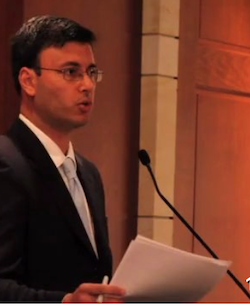 Shastri PurushotmaHow medical care can be substantially improved through a full spectrum view of all factors that affect health was the topic of Payam Etminani's presentation at the 2019 IDGA Veterans Benefits Conference in Washington D.C. Etminani, the CEO of Bitscopic, argued that the ability to view all health data including social, environmental and genomic information in addition to the traditional clinical measures (vital signs, blood work, history of illness etc), would lead to significant improvement in care. Etminani described how recent advances in Big Data and Artificial Intelligence (AI) make combining and using these large and widely varied sets of information possible.
Shastri PurushotmaHow medical care can be substantially improved through a full spectrum view of all factors that affect health was the topic of Payam Etminani's presentation at the 2019 IDGA Veterans Benefits Conference in Washington D.C. Etminani, the CEO of Bitscopic, argued that the ability to view all health data including social, environmental and genomic information in addition to the traditional clinical measures (vital signs, blood work, history of illness etc), would lead to significant improvement in care. Etminani described how recent advances in Big Data and Artificial Intelligence (AI) make combining and using these large and widely varied sets of information possible.
The focus of the conference was to explore ways in which the Veterans Benefits Administration (VBA) could leverage technology to better serve veterans. The VBA is an agency of the U.S. Department of Veterans Affairs (VA) that is responsible for administering programs that provide financial and other forms of assistance to veterans and their families. Etminani's presentation explored how social and economic data from the VBA could be combined with medical data from the Veterans Health Administration (VHA) to provide a new "360-degree" approach that could dramatically improve veteran's care. The VHA is the VA agency that provides medical care to Veterans. It is America’s largest integrated health care system, providing care at 1,255 health care facilities, including 170 medical centers and 1,074 outpatient sites of care of varying complexity (VHA outpatient clinics), serving more than 9 million enrolled Veterans each year.
Expanding the View of Health
Etminani emphasized the importance of taking a broader view of what 'health' means. He said: "Typically, when we look at healthcare data, we are looking at patient's clinical measures (vitals, labs, etc). But 'health' is much more than this. We need to look at other determinants of health such as socioeconomic factors and physical and environmental factors, which will give us far greater insight into a person's overall health than just their healthcare records alone."
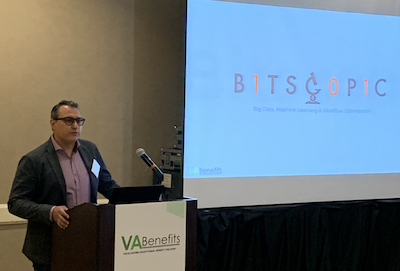 Bitscopic CEO Payam Etminani speaking at VBA conferenceHe described how Big Data and Machine Learning can play a key role in uncovering new insights in this broader picture of healthcare: "When we talk about big data, we are looking at not just the volume, but also the variety and velocity (how quickly the data is changing)." He added that, "working with the VA, we have been able to pull from 10 years of electronic health records from VA systems with roughly 9 million unique patients across 170 hospitals in feeds that refresh multiple times per day."
Bitscopic CEO Payam Etminani speaking at VBA conferenceHe described how Big Data and Machine Learning can play a key role in uncovering new insights in this broader picture of healthcare: "When we talk about big data, we are looking at not just the volume, but also the variety and velocity (how quickly the data is changing)." He added that, "working with the VA, we have been able to pull from 10 years of electronic health records from VA systems with roughly 9 million unique patients across 170 hospitals in feeds that refresh multiple times per day."
Etminani pointed out that Bitscopic has worked at solving some of the hard problems involved in doing this. One example he gave was normalizing the data gathered by the VA's EHR, VistA. This is the process by which data is structured to reduce redundancies and improve accuracy and integrity. Etminani explained that: "In the case of the VA we saw that almost every single hospital or even doctor may have different conventions for how they record microorganism names." He added, "it took us some time, but we have now been able to normalize the data across more than 170 VA hospitals and can search across the system very efficiently."
How the VA System is Unique
Etminani described how the VA system is uniquely positioned to gain insights because it has such a large and comprehensive data set. The VA is the largest healthcare system in the U.S. and its world-class EHR system, VistA, not only has records on all the Veterans that have received care at VA facilities, these records go back in some cases more than 40 years. In addition, because VistA is open source, companies like Bitscopic can tie their solutions to the system. A list of the major applications Bitscopic has already deployed at the VA is shown in Figure 1 below.
 Etminani described how the VA not only has rich healthcare data, but population data as well:
Etminani described how the VA not only has rich healthcare data, but population data as well:
"What other health care organization has such a unique data repository? The VA not only has a vast amount of electronic healthcare data, it also has a rich social and economic population data. When these two major sources of data are combined, imagine the new insights that can emerge! Machine learning models will be able to give predictive attention to specific groups of people even before they become patients (or to prevent them from even becoming patients). Right now, we have developed predictive models that will tell you with a high degree of probability if a patient is going to go septic ahead of time and make recommendations. We look forward to refining these models even further with 'other health determinants' data."
In addition to leveraging population data to improve healthcare data, Etminani described how the benefits can flow in the other direction as well: "The electronic health data can very quickly speed up Veteran's Benefits Administration processing." One example Etminani gave was the case of how the data of a person with specific hemoglobin levels in their charts can automatically be mapped to certain conditions and levels of service injuries and greatly speed up benefits claims processing. In addition, Etminani pointed out that Bitscopic has done some work with Natural Language Processing (NLP) sifting through many thousands of patient charts and records where the volume would completely overwhelm human doctors, concluding that "much of this work can also apply to benefits processing and related work that involves scanning vast amounts of written records."
Four Case Studies
Etminani then described four examples of how Bitscopic was able to dramatically improve healthcare outcomes for the VA using AI and Big Data technologies.
 FDA Safety Alerts
FDA Safety Alerts
When it became known that some heater-cooler devices used during cardiopulmonary bypass surgery at the VA were potentially infected, Bitscopic's Praedico platform was used to rapidly conduct a retrospective investigation of potentially exposed patients. The tool correlated device codes with patient surgery and laboratory data and was able to reduce the time needed to identify the exposed patients from 1,200 hours to only 48 minutes.
The Praedico platform has also been used to detect and help prevent the spread of infectious diseases in the early stages by alerting epidemiologists to anomalies in the data that may necessitate further investigation. As an example, Praedico helped detect the first patient in the US territories who was infected with the Zika virus by spotting anomalies in that patient's medical data.
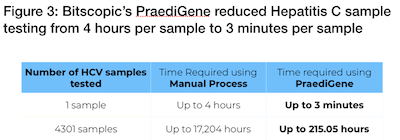 Automated Hepatitis C Sample Testing
Automated Hepatitis C Sample Testing
Bitscopic's PraediGene product is used by the VA to manage the testing of samples for Hepatitis C (HCV). By automating many steps of the previously manual workflow - including automatically communicating results back to the electronic health record system and automated invoicing - the time required to process 4,301 Hepatitis C samples was reduced from 17,204 hours down to 215 hours.
PraediGene is able to achieve these dramatic results because it has the ability to associate and retrieve patient information directly from EHR systems such as VistA. It has DNA analysis features that can automatically predict and report resistance mutations given the organism's genetic sequence. PraediGene also has a financial component that assists with invoicing and billing features customized to the healthcare system's requirements.
 Streamlining Clinical Trial Studies
Streamlining Clinical Trial Studies
Clinical trials often have complex inclusion/exclusion criteria in order to ensure the right profile of patients is fitted to a trial appropriate for their condition. Coupled with the fact that clinical trials often occur on tight timelines, it can be a major challenge for study coordinators to find the right candidates. Bitscopic's PraediTrial product was used at the VA to rapidly identify these "needle in a haystack" candidates and greatly improve the overall effectiveness of the clinical trial process.
PraediTrial ensures a realistic assessment of a trial site's subject population and capabilities to successfully conduct a clinical trial. It alerts study coordinators of subjects that meet the inclusion/exclusion requirements and can provide study monitors authenticated de-identified data directly from the site's EHR system to maximize use of their regulatory and travel budget. PraediTrial also provides study coordinators with a variety of study management tools and can automatically move data from the EHR system to case report forms, increasing the accuracy and decreasing the burdens of manual entry on study coordinators.
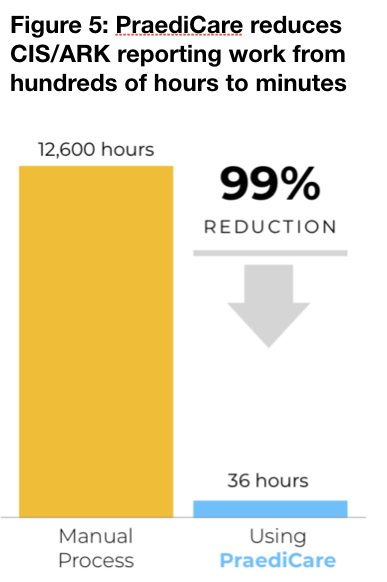 Using Artificial Intelligence to Scan Vast Numbers of Doctors Notes
Using Artificial Intelligence to Scan Vast Numbers of Doctors Notes
Bitscopic worked with the VA on a project to scan doctors notes describing over 30,000 blood test events over an 8-year time period for cases of Pertussis (a highly contagious respiratory tract infection, also known as Whooping Cough). The results on just the first 300 cases were even more accurate than human-read results. When extended to the complexity of many thousands of cases, the platform can quickly perform tasks that would overwhelm humans.
Etminani explained that while this initial pilot project applied natural language processing to scan doctor's notes for the specific case of Pertussis, the additional possibilities for the application of this technology are vast. In the context of the VBA, the large amount of claims procedures and documentation that overwhelms human abilities to process are prime candidates to benefit from automation.
The Human Touch
For all the benefits of technology in healthcare, the point was made in the presentation that the human factor will always be critical. Technology can play a key role in freeing up humans to focus on what they do best - relate to and care for other humans. In the case of working with veterans, an interesting point was made about the unique cultural nuances of working with a veteran's medical situation, and the need for specialized cultural competency and understanding.
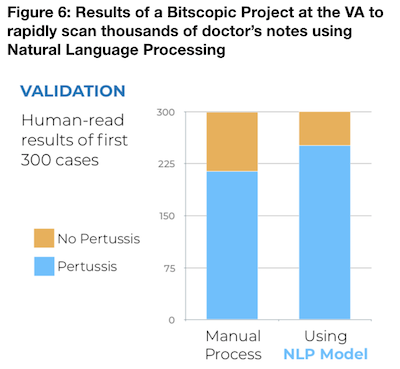 A veteran might be especially inclined to tell a doctor something like: "Well it hurts, but it isn't killing me, so I can just live with the pain!" This would give a distorted picture for the purposes of medical diagnosis, and the need for healthcare providers who understand these cultural nuances becomes all the more critical.
A veteran might be especially inclined to tell a doctor something like: "Well it hurts, but it isn't killing me, so I can just live with the pain!" This would give a distorted picture for the purposes of medical diagnosis, and the need for healthcare providers who understand these cultural nuances becomes all the more critical.
Etminani concluded by emphasizing the need for a greatly expanded view of the meaning of 'health': "The health of a veteran is not just confined to whether that veteran is disease free, but needs to be measured against whole health standards and also against that veteran's personal goals," he said, concluding that: "It is an exciting time to be working with Big Data and Machine Learning to dramatically improve our ability to serve our veterans and to advance healthcare everywhere."
- Tags:
- 2019 IDGA Veterans Benefits Conference
- artificial intelligence (AI)
- benefits processing
- big data
- Bitscopic
- clinical measures
- clinical trial studies
- DNA analysis
- economic population data
- Electronic Health Record (EHR)
- electronic health records
- electronic healthcare data
- epidemiology
- FDA Safety Alerts
- genomic information
- health data
- Health IT
- healthcare data
- healthcare outcomes
- Hepatitis C (HCV)
- machine learning (ML)
- natural language processing (NLP)
- open health
- open source EHR
- Open Source Health IT
- open source software (OSS)
- patient charts
- Payam Etminani
- Pertussis
- population data
- Praedico
- Praedico platform
- PraediGene
- PraediTrial
- resistance mutations
- respiratory tract infection
- social population data
- spread of infectious diseases
- US Department of Veterans Affairs (VA)
- Veterans Benefits Administration (VBA)
- Veterans Health Administration (VHA)
- VistA EHR
- whooping cough
- Zika Virus
- Login to post comments